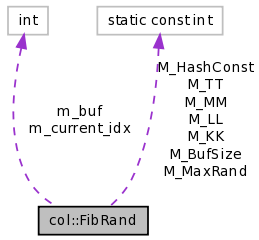
Collaboration diagram for col::FibRand:

Random numbers | |
| FibRand (int seed) | |
| unsigned int | rand (void) |
| Returns a pseudo random integer in the range [0,FibRand::M_MaxRand). | |
| unsigned int | mrand (unsigned int m) |
| Returns a pseudo random integer in the range [0,m). | |
| float | frand (void) |
| Returns a pseudo random float in the range [0,1). | |
Static Public Attributes | |
| static const int | M_MaxRand = (1 << 30) |
| Maximum random number plus 1 that can be returned by FibRand. | |
The constructor creates an object, from which you can retrieve random numbers by any of the functions FibRand::rand(), FibRand::mrand(), and FibRand::frand(). fills a field of 100 random numbers, which can be retrieved
| unsigned int col::FibRand::rand | ( | void | ) |
| unsigned int col::FibRand::mrand | ( | unsigned int | m | ) |
| float col::FibRand::frand | ( | void | ) |
 1.5.2
1.5.2